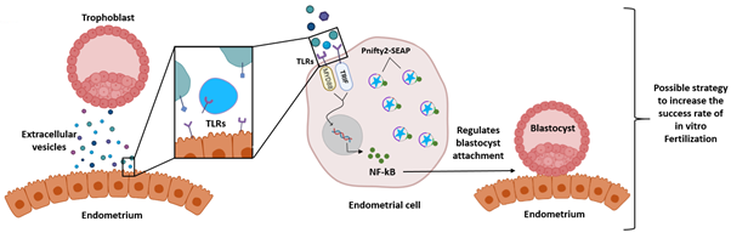Understanding infertility and subfertility in Human and Livestock;
Possible impact of the extracellular vesicles through Toll-Like Receptors
pathways in embryo-maternal cross-talk
Human embryo implantation is still considered to be an enigma since most of the mechanisms involved are not known. Implantation failures account for one third of early embryonic/ pregnancy losses in human as well as in farm animal species. The dysregulation of maternal and embryo communication is thought to be one of the key factors contributing to the poor implantation of embryo. Recent empirical evidences suggest that EVs secreted by the embryo are involved in this maternal-embryo cross-talks in cell and tissue specific manner. The innate immune system is one key regulator of the embryo implantation process since embryo is semi-allogenic in nature. Furthermore, it has been hypothesized that embryo derived EVs could modulate the innate immune system via Toll Like Receptors (TLRs) based signaling pathways. If trophoblast derived EVs can show tropism to endometrial cells and also modulate the TLRs, this could be an approach to treat some of early implantation loses due to immune system mediated rejections of embryo and establishment of pregnancy. Thus, in this project we will try to understand the exact regulatory role of embryo/ trophoblast derived EVs in modulating the embryo-maternal cross talks via TLR pathway.
Project background
In human implantation, when the embryo attaches itself to the endometrium, the semi-allogenic embryo is tolerated by the maternal immune system. In fact, the embryo is supported and nourished by the maternal system. The mechanisms responsible for mediating of this immune tolerance has been a subject for vigorous scientific inquiry through the decades. Recently, the hypothesis of embryo-maternal communication as a method for achieving immunological tolerance state required for this acquired immune ignorance has gained interest. The mechanisms through which the maternal immune system communicates with the embryo and vice versa, is not completely understood. However, many studies implicate EVs as an essential component of this interaction.
EVs has been identified for decades. They were at first considered as a garbage disposal mechanism until recently. In the recent years, the interest on EVs have grown exponentially and they were identified to be released by different cell types from different species. These vesicles are involved in cellular communications because they can carry various biomolecules including nucleic acids, proteins and lipids. Recently, they were also recognized as novel contributors in feto-maternal interaction due to their presence in the female reproductive tract body fluids and their potential to change the transcriptome of the endometrial cells. Previous studies have confirmed the interaction of EVs with the innate immune system through specific receptors such as Toll Like Receptors (TLRs); however, few studies consider this interaction in the process of female immune response to the embryo, which is the aim of our research.
Toll like receptors were the first described as a type of receptors which can recognize pathogen-associated molecular patterns (PAMPs). They are essential factors for the function of the innate immune system due to their ability for binding to various type of ligands such as nucleic acids, proteins and lipids. Since EVs are known to transport many known ligands for TLRs, it can be hypothesized that EV mediated embryo-maternal communication utilizes TLR associated signaling (Figure 4).
In human implantation, when the embryo attaches itself to the endometrium, the semi-allogenic embryo is tolerated by the maternal immune system. In fact, the embryo is supported and nourished by the maternal system. The mechanisms responsible for mediating of this immune tolerance has been a subject for vigorous scientific inquiry through the decades. Recently, the hypothesis of embryo-maternal communication as a method for achieving immunological tolerance state required for this acquired immune ignorance has gained interest. The mechanisms through which the maternal immune system communicates with the embryo and vice versa, is not completely understood. However, many studies implicate EVs as an essential component of this interaction.
EVs has been identified for decades. They were at first considered as a garbage disposal mechanism until recently. In the recent years, the interest on EVs have grown exponentially and they were identified to be released by different cell types from different species. These vesicles are involved in cellular communications because they can carry various biomolecules including nucleic acids, proteins and lipids. Recently, they were also recognized as novel contributors in feto-maternal interaction due to their presence in the female reproductive tract body fluids and their potential to change the transcriptome of the endometrial cells. Previous studies have confirmed the interaction of EVs with the innate immune system through specific receptors such as Toll Like Receptors (TLRs); however, few studies consider this interaction in the process of female immune response to the embryo, which is the aim of our research.
Toll like receptors were the first described as a type of receptors which can recognize pathogen-associated molecular patterns (PAMPs). They are essential factors for the function of the innate immune system due to their ability for binding to various type of ligands such as nucleic acids, proteins and lipids. Since EVs are known to transport many known ligands for TLRs, it can be hypothesized that EV mediated embryo-maternal communication utilizes TLR associated signaling (Figure 4).
Project objectives
- Examining the EV surface proteome and cargo molecules generated from embryos for possible interactions with TLR ligands.
- Using systematic suppression and overstimulation of TLRs in maternal cells to investigate the transcriptomic, biochemical, and proteomic changes that occur in the presence of trophoblast EVs.
- Investigating the effects of EV alterations, such as surface proteome changes, on maternal cell responses.
Integration with EMU expertise, research strategy and development
EMU has a strong research program in relation to reproductive physiology and biology. This may be related to the long roots of reproductive research in EMU. The history of the Department of Reproductive Biology dates back to 1956 when the Laboratory of Artificial Insemination was founded as one of the seven subunits established at the Estonian Research Institute of Animal Breeding and Veterinary Science by a decree of the Ministry of Agriculture of the Estonian SSR. After the merger of the Estonian Research Institute of Animal Breeding and Veterinary Science and the Estonian Agricultural University in 1994, the department was incorporated into the Faculty of Veterinary Medicine of the University. On 1 September 2017, the Department of Animal Genetics and Breeding and the Department of Reproductive Biology were merged to establish the Chair of Animal Breeding and Biotechnology in EMU.
The Chair of Animal Breeding and Biotechnology is Estonia’s only competence center in its field. It offers learning opportunities at all levels of higher education. Basic and applied research involving breeding of livestock, preservation of animal genetic resources, animal genetics, genomics, transgenic technology, reproduction and reproductive disorders, and reproduction biotechnology.
Understanding the mechanisms behind causes of infertility in human as well as infertility and subfertility in animals is a very important aspect of comparative medicine and one health approach. The current research project is well in line with aims of the Combivet project to support research in human and animal based common diseases as well as understanding the mechanism of disease to help Human and animals. All these points are very important in upgrading the quality of research currently performed in EMU.
EMU has a strong research program in relation to reproductive physiology and biology. This may be related to the long roots of reproductive research in EMU. The history of the Department of Reproductive Biology dates back to 1956 when the Laboratory of Artificial Insemination was founded as one of the seven subunits established at the Estonian Research Institute of Animal Breeding and Veterinary Science by a decree of the Ministry of Agriculture of the Estonian SSR. After the merger of the Estonian Research Institute of Animal Breeding and Veterinary Science and the Estonian Agricultural University in 1994, the department was incorporated into the Faculty of Veterinary Medicine of the University. On 1 September 2017, the Department of Animal Genetics and Breeding and the Department of Reproductive Biology were merged to establish the Chair of Animal Breeding and Biotechnology in EMU.
The Chair of Animal Breeding and Biotechnology is Estonia’s only competence center in its field. It offers learning opportunities at all levels of higher education. Basic and applied research involving breeding of livestock, preservation of animal genetic resources, animal genetics, genomics, transgenic technology, reproduction and reproductive disorders, and reproduction biotechnology.
Understanding the mechanisms behind causes of infertility in human as well as infertility and subfertility in animals is a very important aspect of comparative medicine and one health approach. The current research project is well in line with aims of the Combivet project to support research in human and animal based common diseases as well as understanding the mechanism of disease to help Human and animals. All these points are very important in upgrading the quality of research currently performed in EMU.
Project team
|
Seyed Omid Reza Mousavi
Institute of Veterinary Medicine and Animal Sciences Student |
Alireza Fazeli
Institute of Veterinary Medicine and Animal Sciences Supervisor |
|
Subhashini Muhandiram
Institute of Veterinary Medicine and Animal Sciences Student |
Kasun Godakumara
Institute of Veterinary Medicine and Animal Sciences Supervisor |
Suranga Kodithuwakku
Institute of Veterinary Medicine and Animal Sciences
Supervisor
Institute of Veterinary Medicine and Animal Sciences
Supervisor



